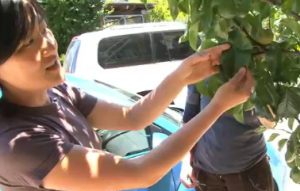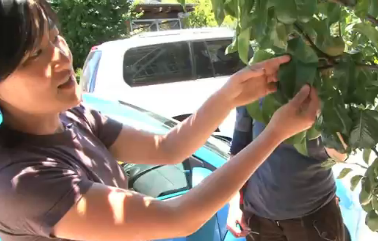
Tara Hui points out an "illegal" Asian pear she's grafted onto an ornamental pear tree.
Ornamental fruit trees are the worst idea ever. And I’d argue they say a lot about our culture. As we’ve built and expanded cities, and planted public trees, we’ve decided that local fruit — fruit you could pick right on the street — was too messy. We wanted our fruit imported, wrapped in plastic, and safely compartmentalized in the produce aisle. So we bred trees accordingly. Pear trees with no pears. Cherry trees with no cherries.
Now this San Francisco-based group called the Guerrilla Grafters is challenging the very notion of the ornamental fruit tree. And they’re working outside the law (city officials don’t like rotten fruit on the sidewalk, nor the liability it suggests). They’re covertly grafting — a practice of connecting two branches in a way that will allow their vascular tissues to join together — fruit tree limbs onto the trunks of ornamental cherry, plum, and pear trees. (We’ve highlighted them before on Grist, but since NPR covered their illegal work again this weekend, I thought it was worth another mention.)
Grafting is fairly invisible to most city dwellers’ eyes, making it an easy, subtle way to fill a neighborhood with fruit-bearing branches over time. But grafting also makes sense on other levels. A strong root system takes time to develop, so branches grafted onto mature trees will grow faster and bear more fruit than they would on young trees. In other words, adding back the fruiting function to established trees (which are also already absorbing carbon dioxide from the air), makes way more sense than tearing out ornamentals and starting from scratch.
Of course, slippery rotten fruit is a factor. (In the NPR segment, we hear from Carla Short, an urban forester for the San Francisco Department of Public Works. “It gets very dangerous very quickly,” she says.) But Tara Hui, the grafters’ spokesperson, has that scenario covered. For every tree that she and the other Guerrillas have added a fruit-bearing branch to, she’s assigned a “steward,” or a designated fruit picker/sweeper. (In this video, for instance, we meet a young steward whose office is located right beside a tree that will soon bear big fat Asian pears.) Assigning individuals and groups with “public” trees to care for is an approach that The Boston Tree Party’s Lisa Gross has also taken, and I’m guessing there is no shortage of people willing to adopt a tree — especially in cities like San Francisco, where one must literally wait years to land an urban garden plot.
Of course, I’ll really start worrying when our cities have more trees than people (I’m not holding my breath). And call me a daredevil, but a few squashed plums on the sidewalk seems like an acceptable hazard if it also means a healthy snack for the walk home.



